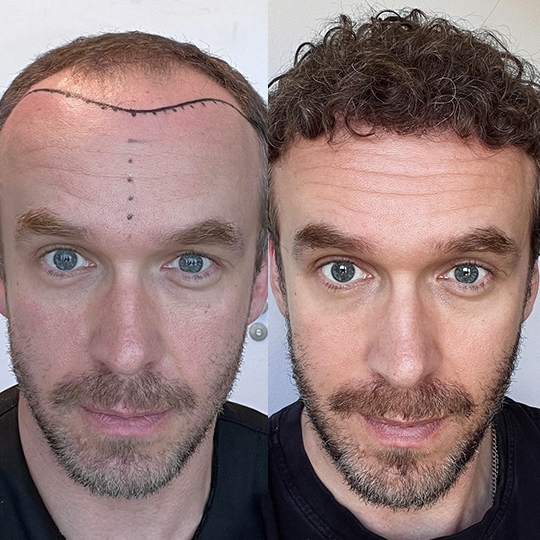Two powerful, minimally invasive treatments: Platelet-Rich Plasma and Mesotherapy — work to restore vitality, enhance hair growth, and rejuvenate the skin from within.
Rejuvenate Your Hair, Skin & Scalp

What is PRP?
PRP uses your own blood to extract growth-factor-rich plasma, which is injected into the skin or scalp to stimulate healing, collagen production, and follicle activity.
- 100% autologous (from your own body)
- Promotes tissue regeneration
- Enhances scalp microcirculation

What is Mesotherapy?
Mesotherapy delivers a cocktail of vitamins, amino acids, and peptides directly into the dermis through microinjections. It’s customized to target specific concerns:
- Hair loss
- Dull or aging skin
- Dehydrated or tired skin
- Scalp health
PRP Therapy vs Mesotherapy: What Sets Them Apart?
| Aspect | PRP (Platelet-Rich Plasma) | Mesotherapy |
|---|---|---|
| Definition | A treatment using a concentration of a patient’s own platelets to promote healing and regeneration. | A technique injecting vitamins, enzymes, hormones, or plant extracts into the skin to rejuvenate and tighten it. |
| Procedure | Blood is drawn, processed to concentrate platelets, then injected or applied to the target area. | A series of microinjections deliver a customized cocktail of substances into the mesoderm (middle skin layer). |
| Main Uses | Hair loss, skin rejuvenation, joint injuries, tissue repair. | Skin rejuvenation, cellulite reduction, hair growth, localized fat reduction. |
| Ingredients | Autologous (patient’s own) platelet-rich plasma. | Varies widely: vitamins, minerals, amino acids, hyaluronic acid, or pharmaceuticals. |
| Downtime | Minimal; some swelling or redness for 1-2 days. | Minimal; possible bruising or swelling for a few days. |
| Results | Gradual improvement over weeks to months as tissue regenerates. | Visible results may appear faster, depending on the goal and substances used. |
Who is PRP For?
Platelet-Rich Plasma (PRP) therapy suits people with early-stage androgenetic alopecia (AGA)—hair loss due to genetics and hormones, typically thinning on the crown in men and along the parting in women. PRP has become a promising treatment modality for AGA, offering a non-surgical option that utilizes the body’s own growth factors to stimulate hair follicles. Results vary by age, hormones, and cause: some see thicker hair within months, others modest changes. PRP doesn’t fully cure hair loss but maintains its appearance, especially when combined with treatments like minoxidil or laser therapy.

Who is Mesotherapy For?

Mesotherapy may be a beneficial supportive treatment for androgenetic alopecia (AGA), particularly in men at Norwood stages I to IV, where hair follicles are still present but weakened. Mesotherapy involves injecting various bioactive substances like vitamins, plant extracts, or cytokines directly into the scalp. While more high-quality research is needed, mesotherapy is commonly used alongside established treatments such as minoxidil, PRP, or oral medications to enhance outcomes.
PRP - FAQ
Yes, PRP can help regrow hair — especially in the early stages of androgenetic alopecia. It stimulates dormant follicles and improves blood flow, leading to thicker, healthier hair. However, it doesn’t create new follicles where none exist.
No. PRP is not effective on completely bald areas (e.g., Norwood stage VI–VII) where hair follicles are already destroyed. In such cases, a hair transplant may be necessary.
Results typically last between 6 to 12 months. Maintenance sessions are often recommended every 4 – 6 months after the initial treatment course.
Studies show that 70–85% of patients experience improved hair thickness, density, and reduced shedding. Outcomes depend on individual factors such as hair loss stage, age, and hormonal balance.
PRP therapy costs vary by location and clinic. Average prices per session:
Mexico: ~$300-$500 USD
United States: 500–500–1,500 USD
Europe: €400–€900
India: ₹15,000–₹25,000
If you’re in the early to mid stages of hair loss (Norwood I–IV) and still have active follicles, PRP can be a worthwhile investment. However, it’s not permanent — ongoing maintenance is usually needed.
They work differently:
Minoxidil increases blood flow and stimulates growth but must be used daily.
PRP uses natural growth factors from your own blood to rejuvenate follicles.
👉 The best results often come from combining PRP and minoxidil.
People with fully bald areas or scarred scalp (late-stage hair loss)
Those with blood disorders or low platelet count
Active infections on the scalp
Autoimmune or cancer patients (especially in active treatment)
Mesotherapy - FAQ
Mesotherapy involves injecting a customized mix of vitamins, enzymes, peptides, and other active ingredients into the skin or scalp. For hair loss, it aims to improve blood circulation, nourish hair follicles, and stimulate growth. For skin, it helps with hydration, brightness, and texture improvement.
Prices vary depending on the treatment area, country, and clinic.
In our clinic, the cost of one mesotherapy session is $300usd.
Potential downsides include:
Temporary redness, swelling, or bruising at injection sites
Risk of infection if not done properly
Results are not permanent and require maintenance
Effectiveness may vary from person to person
Not FDA-approved specifically for hair loss
Results typically last 3 to 6 months, depending on your skin/hair condition, lifestyle, and whether maintenance treatments are done.
Discomfort is usually mild. Most patients describe it as a series of small pinches or stings. Topical numbing cream is often used to reduce pain.
Mesotherapy is not recommended for:
People with active skin infections or inflammation
Pregnant or breastfeeding women
Individuals with blood clotting disorders or autoimmune diseases
People allergic to any ingredients in the injection cocktail
Yes, mesotherapy is legal in the U.S., but it is not FDA-approved for treating hair loss or fat reduction. It is considered an “off-label” cosmetic treatment, and should be performed by licensed professionals.
No, mesotherapy is considered a cosmetic procedure, so it is not covered by health insurance.

Find Out If Hair Transplantation Fits Your Needs!
If you’re looking for best results, don’t hesitate to reach out. Send us a message, and we’ll be happy to answer all your questions and guide you through the process.
- Av. Huayacan esq. Calle Ciricote Smz. 313 Mza. 257 Local 1-100, 77500 Cancún, Q.R.
- clinic@hairtransplantbyturkish.com